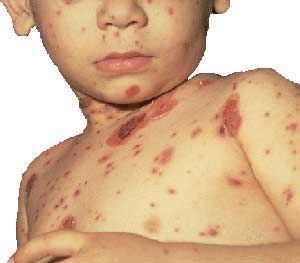 |
2 to 4 days before the appearance of chickenpox, the disease is already contagious |
“Ho Chi Minh City has begun to see cases of chickenpox, even though March is typically the peak outbreak period. To limit the spread of the disease during this peak season, anyone who has not had chickenpox should get vaccinated now,” said Dr. Truong Huu Khanh from Children’s Hospital I.
According to Dr. Khanh, to date, the issue of vaccination against chickenpox has not received sufficient attention from the public. As a result, every year, during the outbreak period (from February to June), hundreds of cases require hospitalization. Statistics from Children’s Hospital I show that in the last two years, March alone has seen up to 1,000 hospital admissions. In other months, there is an average of 80 to 100 children hospitalized for chickenpox.
Chickenpox is caused by the Varicella Zoster virus. Most patients are children aged 5-11. The characteristic symptoms of this disease include itching, skin rashes, and vesicular lesions often accompanied by fever. Initial signs include fever, fatigue, loss of appetite, and muscle pain. Subsequently, spots appear on the scalp and face, spreading down to the limbs, with the number of spots reaching up to a thousand, causing severe itching and discomfort. The disease usually progresses mildly, but if not properly cared for, it can lead to serious complications ranging from bacterial superinfection to encephalitis.
When the disease manifests, if superinfection occurs, it can leave permanent scars. The most common and dangerous complication of chickenpox is shingles (also known as herpes zoster). This condition is more painful than chickenpox and can last for many years. Additionally, chickenpox can adversely affect the central nervous system, leading to pneumonia, which can result in death.
 |
Varicella Zoster Virus |
The danger of the disease lies in the fact that when infected with the virus, individuals often do not exhibit symptoms in the first two weeks, but 2 to 4 days before the appearance of chickenpox lesions, the disease is already contagious. Even after the vesicles have appeared for 6 days, the virus can still spread from the infected person. Studies indicate that 90% of unvaccinated individuals are at risk of contracting the disease. This means that an unvaccinated person who comes into contact with an infected individual will certainly contract the disease. People are easily infected through the air, via saliva when the infected person sneezes or coughs, or through contact with the vesicles of the sick person. The disease can also be transmitted from mother to child.
Therefore, Dr. Khanh advises: “To avoid contracting and spreading the disease to others, everyone should get vaccinated against chickenpox. Vaccination not only helps individuals avoid the disease but also reduces the annual outbreak risk.” The chickenpox vaccine provides long-lasting immunity (almost lifelong) for those vaccinated. Children from 9 months to 12 years only need one subcutaneous dose. Children over 13 years need two doses, each spaced 4-8 weeks apart. Individuals can visit district health centers, hospitals, or the Pasteur Institute for vaccination.


















































